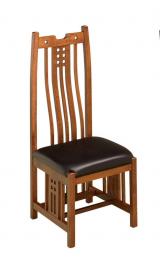Our store carries a number of styles and we will attempt to briefly describe them here. There are two things you should know: Amish furniture is not a style, rather it is a dedication to craftsmanship in carpentry passed down through generations. We tend to represent Craftsman styles in our store but there are catalog items from our producers that are quite modern, and we have commissioned Amish craftsmen to work from plans and create very contemporary pieces.
The Styles in a nutshell: Arts and Crafts (A&C): showcasing of joinery, be it mortise and tenon or wedge-pin construction. Simple and utilitarian, though chunkier and more heavy than Shaker furniture.

Mission: straight 90 degree angles, no tapering of legs, slats and rectangular spindles. Royal Mission is another derivative in this vein that has more spindles and some inlay accents.

Prairie: straight out of Chicago, this genre was pioneered by Frank Lloyd Wright. Utilizes many narrow spindles and few curves. It might look to you like a busier version of a Mission design.

Shaker: gentle tapers and slight hooking at the bottom of legs. Shaker furniture is also quite unadorned, slimmer than Mission styles and typically lighter weight. Simple and functional pieces with mushroom shaped knobs
.
Chippendale, Queen Anne and Colonial: These traditional English furnishings are more elaborate decorative styles. Chippendale is characterized by classical ornamentation. The Queen Anne is notable for its cabriole legs and pad or claw feet. The Colonial style is a more conservative take on Queen Anne, often leaving out unnecessary details.

Pennsylvania Dutch: American country style furniture often with turned legs (carved round legs with decorative grooves). Some of the Pennsylvania Dutch pieces have painted portions combined with stained or natural wood grain surfaces. Incidentally, the German based language that Amish folks speak to one another is called Pennsylvania Dutch.

Contemporary: There are a plethora of new directions in the furniture industry, and Amish producers in Northwest Indiana do their best to keep current with trends.


The roots of the styles The American Craftsman genre was born when Gustav Stickley traveled to England to discover for himself the English Arts and Crafts genre. Craftsman was the chosen title for a movement that emphasized artisanship and showcased the functional wood-joinery that was frequently concealed by other styles. Both Mission and A&C styles emphasize a reduced design: unadorned furniture that allowed the beauty of the wood grain to be showcased. In reaction to the Victorian design movement, the Craftsman movement pushed the pendulum back towards a much understated interior. Idealistically, the craftsman movement was in support of handmade objects and constituted a reaction against the dehumanizing aspects of the Industrial Revolution. Soon the straight lines of the Craftsman styles were labeled Mission--as in the southwest Spanish and Mexican homes around California. Today we can sometimes distinguish between Arts and Crafts and Mission, usually calling something A&C if it has through-tenon joints, subtle arches, and rough hammered metal hardware compared with the angular and clean lines of Mission. In the greater Chicago area there is a lot of architecture with the same heritage--homes and other buildings built with the same Craftsman ideal. Bungalow style homes are especially suited for Arts and Crafts and Mission style furnishings, as the emphasis is on simple and functional living.
